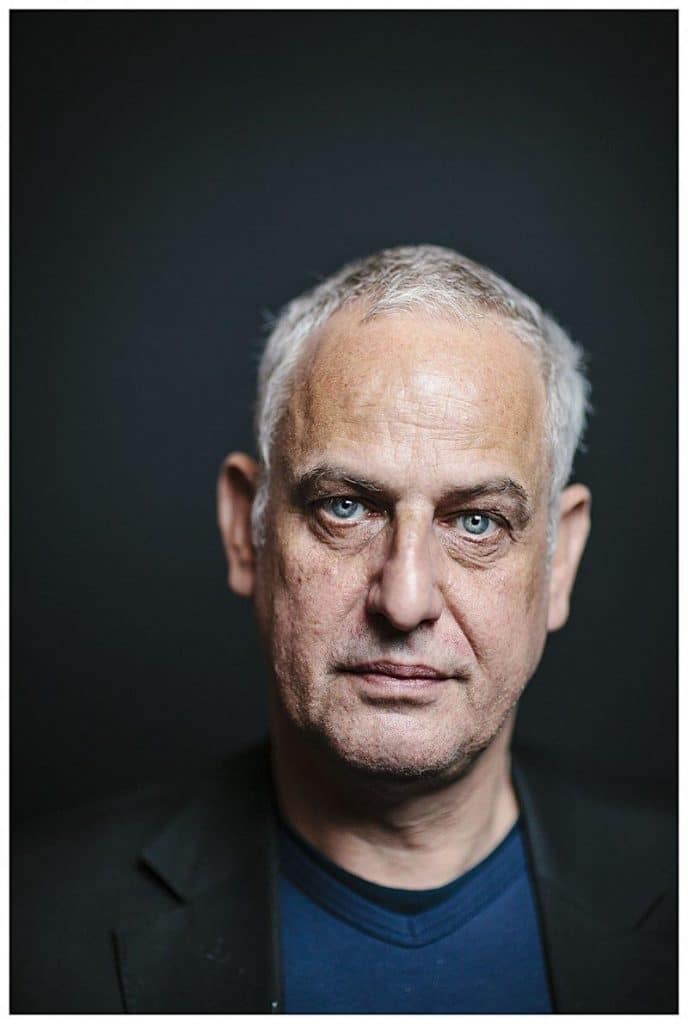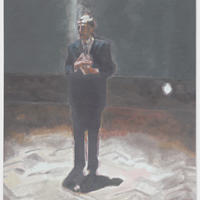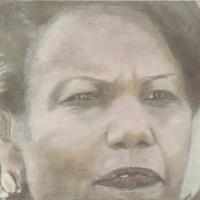More about Luc Tuymans
Works by Luc Tuymans

Contributor
Luc Tuymans, perhaps the most serious looking man in the world, makes art on par with his RBF.
The portraits he paints of himself and other people are serious. His still-lifes are serious. His color palette is serious. You get the picture. He’s no ray of sunshine, which actually fits in with the weather of his hometown, Antwerp, Belgium. It makes sense that the gloomy, wet weather would seep into his work a little bit but jeez, Tuymans, buy a UV lamp, get some Vitamin D supplements and deal with it.
There may be a little more to Tuymans’ dark side than seasonal depression though. There was a lot of familial tension due to the fact that his mother’s side of the family was part of the Dutch resistance during World War II and his father had two brothers in the Hitler Youth program. This was a family secret until one day when Tuymans was 5 years old, a picture of his uncle, Tuymans’ namesake, dressed in a Hitler Youth uniform fell out of a family photo album. This basically destroyed the family as “the issue ‘was always looming’ in his parents’ home. The marriage was not a happy one, and with his mother more and more outspoken on the subject and his father increasingly introverted, Mr. Tuymans said, ‘I learned to eat very fast and get away from the table.’” And you thought your family was dysfunctional…
Another super awkward moment in Tuymans’ life was in January 2015 when he was sued for plagiarism for using a copyrighted picture as artwork inspo. European courts can be a little stiff that way. Tuymans was found guilty but appealed and the matter was settled amicably and confidentially outside of court. After this incident you would think that Tuymans would move to America, where people like Sherrie Levine have careers, but he’s too much of a patriot for that.
Sources
- Spears, Dorothy. "Luc Tuymans, Putting The Wrongs Of History In Paint". Nytimes.com. N.p., 2010. Web. 30 Apr. 2017.
- "This Year’S Biggest Art News Stories". Artsy. N.p., 2015. Web. 30 Apr. 2017.
- Bush, Lewis. "Luc Tuymans Case Illustrates The Failure Of Europe's Copyright Laws". Hyperallergic. N.p., 2015. Web. 30 Apr. 2017.
- Eastham, Ben. "A Necessary Realism: Interview With Luc Tuymans | Apollo Magazine". Apollo Magazine. N.p., 2015. Web. 30 Apr. 2017.
Featured Content
Here is what Wikipedia says about Luc Tuymans
Luc Tuymans (born 14 June 1958) is a Belgian visual artist best known for his paintings which explore people's relationship with history and confront their ability to ignore it. World War II is a recurring theme in his work. He is a key figure of the generation of European figurative painters who gained renown at a time when many believed the medium had lost its relevance due to the new digital age.
Much of Tuymans' work deals with moral complexity, specifically the coexistence of 'good' and 'evil'. His subjects range from major historical events such as the Holocaust to the seemingly inconsequential or banal: wallpaper, Christmas decorations or everyday objects for example.
The artist's sparsely-coloured figurative paintings are made up of quick brush strokes of wet paint. Tuymans paints from photographic or cinematic images drawn from the media or public sphere, as well as from his own photographs and drawings. They often appear intentionally out of focus. The blurred effect is, however, created purposefully with painted strokes, it is not the result of a 'wiping away' technique.
Formal and conceptual oppositions recur in his work, which is echoed in his remark that while 'sickness should appear in the way the painting is made' there is also pleasure in its making – a 'caressing' of the canvas. This reflects Tuymans' semantic shaping of the philosophical content of his work. Often allegorical, his titles add a further layer of imagery to his work – a layer that exists beyond the visible. The painting Gaskamer (Gas Chamber) exemplifies his use of titles to provoke associations in the mind of the viewer. Meaning, in his work, is never fixed; his paintings incite thought. A related characteristic of Tuymans' work is the way he often works in series, a method which enables one image to generate another through which images can be formulated and reformulated ad infinitum. Images are repeatedly analysed and distilled, and a large number of drawings, photocopies and watercolours are produced in preparation for his oil paintings. Each final painting is, however, completed in a single day.
Check out the full Wikipedia article about Luc Tuymans












